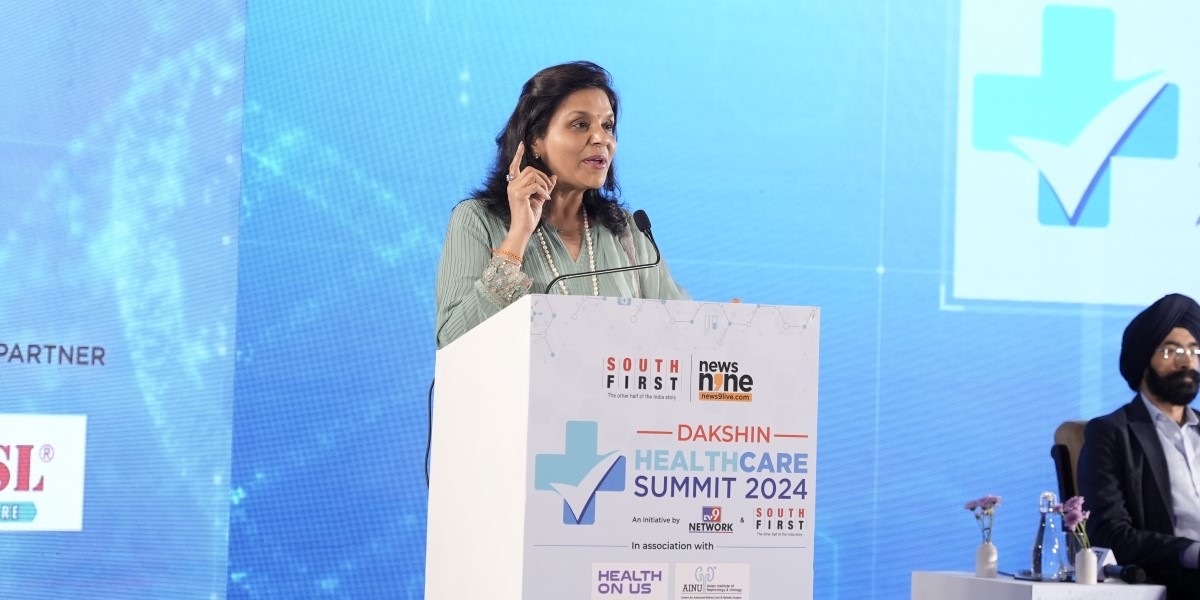At the inaugural Dakshin Healthcare Summit organised by South First and TV9 Network, Dr Sangita Reddy, joint managing director of Apollo Hospitals, painted a vivid picture of this future in her keynote address.
Published Aug 06, 2024 | 7:00 AM ⚊ Updated Aug 06, 2024 | 4:23 PM

Dr Sangita Reddy. (South First)
Imagine a world where the boundaries of medicine are constantly being redefined — where the power to reprogram cells is not just a distant dream but a reality within our grasp.
At the inaugural Dakshin Healthcare Summit organised by South First and TV9 Network in Hyderabad on Saturday, 3 August, Dr Sangita Reddy, joint managing director of Apollo Hospitals, painted a vivid picture of this future in her keynote address.
“The promise of the future is super exciting,” she said, highlighting the thrilling possibilities, as we stand on the cusp of promising advances in medical science.
Dr Sangita Reddy primarily spoke of three Bs in her keynote address — Biology, Bandwidth, and Bytes — which have transformed healthcare.
Explaining each “B”, Dr Sangita Reddy noted, “Biology is discovering one’s genetic makeup, bandwidth is something that helped us to connect remote villages to different areas and lastly the bytes that are largely based on computing capacity.”
Elaborating the last “B”— the bytes, she added, “With that computing capacity, our CT scans advanced from 64 slices to 120 slices to 640 slices, allowing us to see and do more.”
The number of slices refer to the number of anatomical images per rotation, as the number of slices increases, the scan time decreases, and efficiency of the scan increases.
Continuing her address, Dr Sangita added, “Following this, artificial intelligence brought more computing power, analytics, and an understanding of why a certain person’s gene expression varied.”
“With these numerous changes happening, I think it was very well described: From robotics to artificial intelligence, to stem cell research, to virtual reality,” Dr Sangita said speaking of the Dakshin Healthcare Summit.
Interacting with the audience, Dr Sangita asked, “I wonder how many of us have considered the probable age we might live to. A number in mind?, is there a 100 (years)?.”
Speaking of her personal experience, Dr Sangita gives an example of Peter Diamond’s take on the “abundance mindset.”
“Abundance mindset” emphasises the abundance of resources and medical capability that is provided in the world where nobody needs to starve from the very provision. She went on to praise the knowledge that is available to everyone which makes the belief in longevity much more prevalent.
Throwing light on the other side, Dr Sangita spoke of the World Economic Forum’s prediction of jobless growth where the number of job opportunities is reducing but people will live longer. “This introduces a different problem altogether.”
Dr Sangita urged the conscious and responsible members of the society to understand the juxtaposition of jobless growth and longevity.
Dr Sangita swiftly moved to the endless possibilities of healthy longevity, in which she discusses about the “Yamanaka factors”.
Shinya Yamanaka is the scientist behind the “Yamanaka factors”, which is the basis behind cell reprogramming.
The “Yamanaka factors” allows to take one cell and reprogramme into any cell.
Speaking of the possibilities of the method to treat any ailment, Dr Sangita gave an example about the regeneration of liver cells which eventually cancel out the need for liver transplants.
She added, “I predict that in twenty years from now, we will not be doing the joint replacements that everybody’s doing routinely because we would have treated it much earlier. Whether we’re doing stem cell injections to regenerate cartilage or using AI to gate analysis and therefore gate correction and prevent or reduce the wear and tear on the joints. Eventually changing the way we live.”
She mentioned that there are multiple factors in addition to the knowledge and awareness of medicine, in relation to controlling the environment.
Citing the example of microplastics, that have become a part of the body, Dr Sangita added, “We will modify the detection and treatment of microplastics.”
Dr Sangita concluded by stating, “This is India’s time.”
“We have the capability to analyse and work hard to research. On the health side, we now have data, we can use the technology to start analysing.”
She further hoped that interactions and programmes like the Dakshin Healthcare Summit accelerate the pace of investment into research and enable India to change the positioning we have had in healthcare.
Dr Sangita expressed a new vision and new dream of India setting the agenda.
(Edited by Sumavarsha Kandula)
